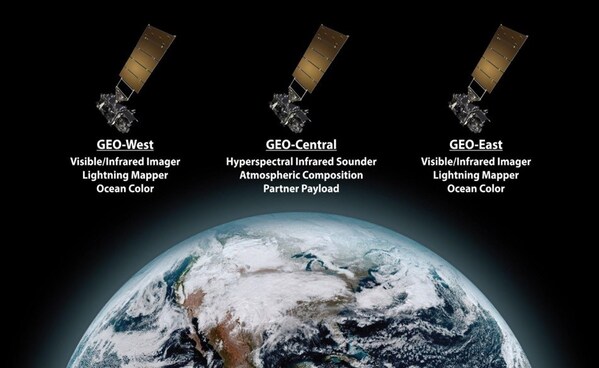
NASA, representing the National Oceanic and Atmospheric Administration (NOAA), has tapped Lockheed Martin Corp. to assemble the spacecraft for NOAA’s Geostationary Extended Observations (GeoXO) satellite program. The contract, valued at approximately $2.27 billion, covers the creation of three spacecraft and offers options for four additional ones.
Lockheed Martin will carry out the work in its facility in Littleton, Colorado, and NASA’s Kennedy Space Center in Florida. Each contract allows for 15 years of support, including 10 years of on-orbit operations and five years of on-orbit storage for each spacecraft. The GeoXO constellation will comprise three operational satellites equipped with different instruments based on their geostationary position. The centrally-positioned spacecraft can house an infrared sounder and atmospheric composition instrument as well as partner payload.
The east and west satellites will feature an imager, a lightning mapper and an ocean color instrument, plus an auxiliary communication payload supporting NOAA’s Data Collection System relay, dissemination and commanding. Contractually, Lockheed Martin is required to handle all aspects of satellite creation from design to fabrication, testing and launch support. They will also supply ground support equipment and simulators and assist in mission operations at NOAA’s Satellite Operations Facility in Suitland, Md.
The GeoXO program is a successor of the Geostationary Operational Environmental Satellites – R (GOES-R) Series Program and is set to improve Earth observations from a geostationary orbit. NASA and NOAA jointly oversee the program’s development, launch, testing and operation, with NOAA funding and handling operations and data products. In collaboration with commercial partners, these agencies develop and create the instruments and spacecraft and perform the satellite launches.
The GeoXO satellite system will provide essential data to tackle future major environmental challenges supporting weather, ocean and climate operations in the United States. Advanced features from GeoXO will assist in assessing changes on our planet and in meeting the evolving needs of the nation’s data users. Both NASA and NOAA aim to have these vital observations from GeoXO in place by the early 2030s, around the time when the GOES-R Series is expected to conclude its operational life.